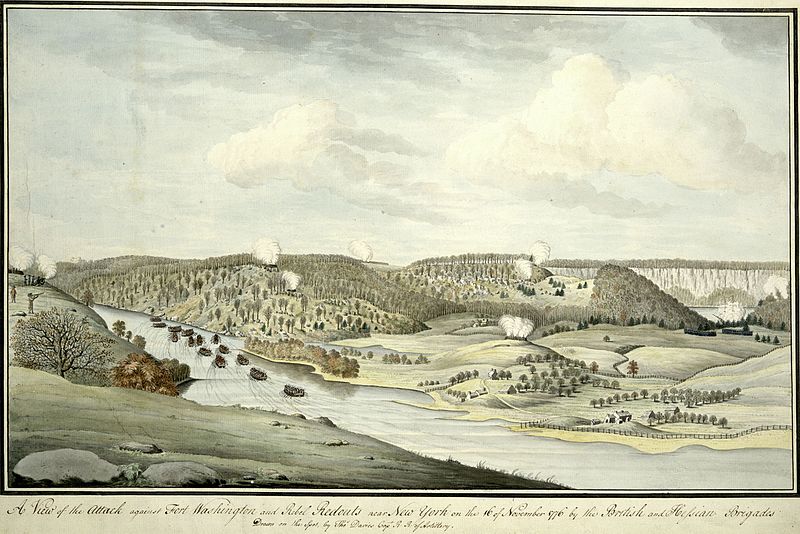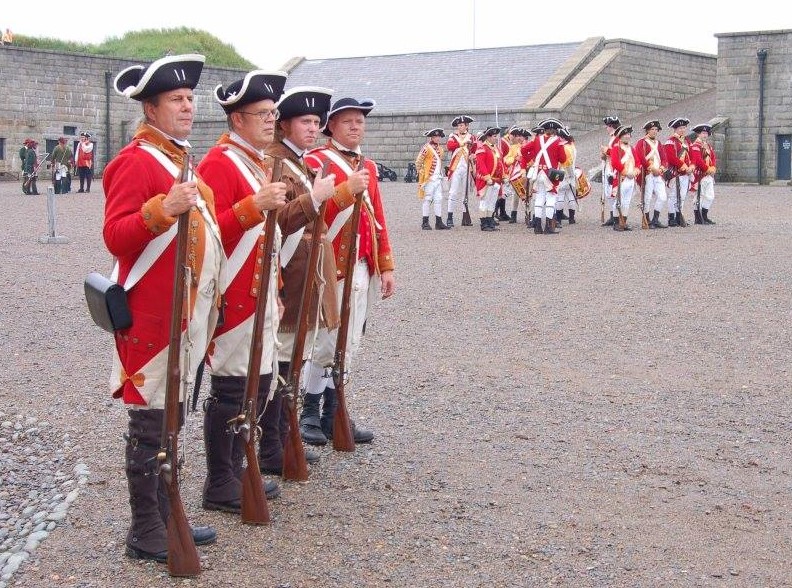New Brunswick Loyalist Journeys: Meet the Loyalist Youth
We are pleased to announce that two new chapters have now been added to the New Brunswick Loyalist Journeys story map project. You will now find twenty additional biographies of loyalists from Kings County and St. John County, New Brunswick. Please visit the project site for the complete biographies of the loyalists featured in this post and others: https://loyalist.lib.unb.ca/story-maps .
A continuing challenge to loyalist studies is the inclusion of the biographies of “average” loyalists. It is, however, possible to reconstruct individual paths of less prominent refugees of the American Revolution by gathering a variety of documents spanning the American and Maritime colonies. Alexander Fairchild, Gabriel Fowler, and Gasper Maybee were young men at the outbreak of the American Revolution and came from families involved in trades and/or of middling farming backgrounds. They each chose to join a provincial (loyalist) regiment, went on to have varied and geographically widespread experiences throughout the war years, and then resettled in New Brunswick and started families.
Alexander Fairchild (b. 1753, New Fairfield, Connecticut; d. 1787/8, Kingston, New Brunswick) Through the course of the American Revolution, Alexander Fairchild was transformed from a young, outspoken loyalist who escaped from the most notorious prison in Connecticut, into a seasoned, military veteran in the Prince of Wales’ American Volunteers Regiment. He strived to establish a family and farm after his post-war migration to New Brunswick but died at a fairly young age.
Fairchild was indicted for high treason at the age of twenty-three in 1776 and sentenced to imprisonment for two years in Simsbury Mine, also known as the Old New-Gate Prison. After about four months of imprisonment, however, Fairchild was able to stage an escape, which was advertised in The Connecticut Courant newspaper on December 2, 1776. This account provides a rare description of a working-class loyalist as follows: “Broke out at Newgate Prison in Simsbury, the morning of the 15th . . . about 6 feet high, dark coloured hair, which he wares club’d, had on a blue coat, red waistcoat, claret coloured surtout, and leather breeches . . . ”

(Credit: “View of the guard-house and Simsbury mines, now called Newgate, printed by The Political Magazine, London, 1781; print, museum purchase, 1984.49.15, the Connecticut Historical Society”)
He made his way to New York City, and became a sergeant of the Prince of Wales’ Royal American Volunteers for the remainder of the war. The exploits, posts, and engagements of the regiment ranged from Long Island to Connecticut and Rhode Island to South Carolina, including the Battle of Hanging Rock. The impact of the engagement on the regiment was immense, with the unit suffering huge casualty rates. It is unclear as to Fairchild’s situation after Hanging Rock, but he would be one of the few sergeants to complete their tenure in the Prince of Wales’ Regiment. At the end of the war, what was left of the Prince of Wales’ was disbanded at Parrtown (Saint John, New Brunswick) on October 10, 1783 after over six years of service.
Many of Fairchild’s relatives were carpenters, a trade which Fairchild practiced after his military career at Fort Howe in Saint John. Fairchild’s marriage to Ann Seeley was one of the first recorded Anglican marriages in Saint John in 1786. They had one daughter, Clara, in 1787. After an unsuccessful petition for land in Saint John, Fairchild’s intended residence was at Long Reach on the Kingston Peninsula. He also held a farm in Douglas, York County which was part of the grant given to the Prince of Wales’ Regiment. Fairchild’s will was written on November 9, 1787 and proved on February 14, 1788 in Kingston, Kings County, indicating his death was not unexpected. The military experiences of loyalist tradesman, Alexander Fairchild, provide an unusually detailed example of life in a provincial regiment.
Gabriel Fowler (b. c. 1756, Harrison’s Purchase, New York; d. 1832, Hampton, New Brunswick) Harrison’s Purchase, Westchester County, New York, became a major centre of conflict during the American Revolution and the turbulent location of Fowler’s hometown shaped his experience during the war and also his subsequent migration. As a teenager when the war erupted, Fowler engaged in the conflict by joining various loyalist military and militia groups. He then moved to New Brunswick with members of his family in 1783 where he developed a farm in French Village, Kings County.
Fowler’s father was a farmer and leader in the new town of Harrison or Harrison’s Purchase, but the family property was taken over by patriots during the Revolution. Gabriel Fowler claimed to be part of the Guides and Pioneers Regiment during the war and then an ensign in the Westchester Refugees, a militia group based in Morrisania, New York mainly involved in raiding, although there are no apparent supporting contemporary military documents for these assertions. Fowler also said via his loyalist claim to the British government for compensation that he had been taken prisoner for eighteen months while a member of the Westchester Refugees, but there was also a “Gabriel Fowler” in civil prison, The Provost of New York City, at the same period of time.
(Credit: Leah Grandy, UNB Libraries)
Fowler had two wives, the first being Abigail Leggett, whom he likely married in 1779 or 1780 in New York. Their son, Samuel, was born around November 1780, but unfortunately Abigail died before they emigrated to New Brunswick in 1783. Fowler brought an enslaved teenage girl, Stach, with her baby to New Brunswick to take care of his son. His second marriage was to Jane Hatfield with whom he had seven children. The family, including his parents, had first tried to settle at Burton, Sunbury County, then Hammond River. He became the first warden of St. Paul’s Lakeside Anglican Church and was buried in its cemetery.
Gabriel Fowler’s death was reported in the New Brunswick Courier on April 21, 1832: “d. Thursday Gabriel Fowler age 75. Funeral at Hampton Church. Came here at end of Revolutionary War.” These were short words to summarize a life that had survived years of war in the chaos of Westchester County, New York, and the hardships of migration and establishing a homestead in New Brunswick.
(Credit: Leah Grandy, UNB Libraries)
Gasper Maybee (b. 1750, Paramus, New Jersey; d. 1822, Saint John, New Brunswick) Like many loyalists who migrated to New Brunswick, Canada, Maybee was a young man at the beginning of the American Revolution and chose to join a provincial regiment, the King’s Orange Rangers. He stayed with the regiment throughout its years in New York and Nova Scotia, then was one of the few members who settled the land they were allotted at St. Martins, New Brunswick. Maybee was married to Abigail, and most likely had several children who were born in New Brunswick.
Maybee came from a large family of which he was the fourth oldest son. Soon after the British military success in December 1776, a new provincial loyalist regiment, the King’s Orange Rangers was formed at Paulus Hook (now Jersey City, New Jersey), of which Maybee was an early recruit at the age of twenty-six, listed as “Private Gasperus Mabee.” An outbreak of smallpox in January 1778 instigated a move of the KOR to Harlem and was accompanied by a total breakdown of discipline in the ranks. Maybee was at Fort Knyphausen, New York in April 1778, but his company had hardly any members, Maybee being one of three privates left.

(Credit: Thomas Davies, “A View of the Attack against Fort Washington and Rebel Redouts near New York on the 16 of November 1776 by the British and Hessian Brigades,” Public domain via Wikimedia)
In September, Sir Henry Clinton wrote to the Lieutenant Governor of Nova Scotia, Richard Hughes, that he was sending the King’s Orange Rangers along with other troops to Nova Scotia. Although it is fair to presume that Maybee was sent to Nova Scotia in 1778 with the rest of his regiment, it is unknown where he was stationed. Most likely, he was stationed at the Eastern Battery in Dartmouth, Point Pleasant in Halifax, or George’s Island in Halifax Harbour, and perhaps later to Fort George (now Citadel Hill in Halifax). At the end of the war, Gasper would take up land in the grant which was specifically allotted for the KOR at Quaco, New Brunswick.

(Credit: Image courtesy of King's Orange Rangers Society)
Quaco, located east of Saint John on the Bay of Fundy, would become known as St. Martins and it was where Gasper Maybee received 350 acres. Of the original land grant made to seventy-nine members of the KOR in Quaco, only eight took up the grants and stayed until the land was re-granted in 1796. Toward the end of the eighteenth century, Gasper began to sell off his land in Quaco. By the 1790s, Maybee became a freeman of the City of Saint John and made the move to the city as his main residence.
Gasper Maybee had come from a loyalist family and enclave in Bergen County, New Jersey, and made his way through the chaos of war via the King’s Orange Rangers to Nova Scotia. The regiment’s unique path then led him to New Brunswick, where he became one of the first colonial settlers of St. Martins.
Leah Grandy holds a PhD in History and works as a Special Collections Assistant at UNB Libraries.
SUBJECTS: loyalist, New Brunswick, GIS, map, digital humanities, story map, biography, military



Comments
Carol Drayton (not verified)
Mon, 03/06/2023 - 12:05
Permalink
Eliza Chambers born1769 in New Brunswick
I'm searching for my ancestor Eliza Chambers who was allegedly born in Tabusintac allegedly in 1769, but I can't find evidence that there was any white settlement there until later in the century. Can you advise?
Carol Drayton
carol47drayton@gmail.com
I am descended from the Murray's and the Loggies of that area.
lgrandy
Mon, 03/06/2023 - 12:18
Permalink
Eliza Chambers
Hello, for reference questions, you can send us a message at mic@unb.ca. I would also advise using the resources at the Provincial Archives of New Brunswick.
Add new comment